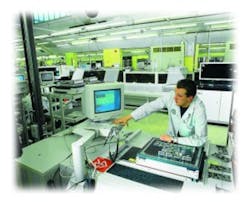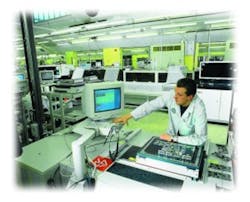One frequently emphasized problem was the constant pressure to hold down the costs of equipment and labor. Also, there are the needs to support extremely high production rates and quickly convert a test station from one product to the next at the end of a production run. How do they accommodate such diverse demands? Let’s take a look.
Types of Test
The usual contract-manufacturing scenario includes several levels of testing. The objective is to select the most appropriate place in the manufacturing process for each level of inspection, test, and debugging to minimize the costs.
Inspection and test stations weed out defects in the early stages of production. The automated optical inspection (AOI), possibly automated X-ray, and in-circuit testers catch most manufacturing defects. Then at final test, an expensive, automated functional tester spends a few seconds to a few minutes intensively checking each product before making a go, no-go decision.
Troubleshooting sites present a unique equipment and staffing situation. Typically, the diagnostic site is just a few feet from the production line and staffed by personnel trained to diagnose problems of the products being manufactured. Some contracts call for the products to be shipped directly to the end user or distributor. In these cases, the contract manufacturer is likely to handle in-warranty diagnostics at these same troubleshooting stations.
At some contract manufacturers, a relatively new capability is provided by a small, not-very-expensive in-line functional tester configured for a specific set of tests on a subassembly of the product. This station can be built from standard modules, powered by a PC, and operated with standard software. This equipment can find defects early in the cycle, when the cost of detection and repair is the lowest.
Even though they may be thousands of miles apart, there is a definite partnership between test engineers at the contract manufacturer and the product designers. However, two common difficulties plague the test engineer:
- They would like to get the pre-release drawings with less to-be-determined (TBD) notations. Each of these TBDs requires the test engineer to make a risky guess before proceeding with equipment design and installation.
- They would like the design engineer to be more concerned about product testability. As one test manager complained, “Too often, testability with circuit access, test points, and other considerations seems to be the last thing a designer considers. Our jobs would be simpler and our costs lower if we could access the appropriate places in the products.”
Because of increased complexity of PCBs and the resulting difficulty of access, the cost of in-circuit test has increased and the effectiveness decreased. This is why the use of this type of test station at some contract manufacturers seems to be leveling off. The alternatives, AOI, X-ray inspection, and small functional testers, are becoming popular.
Three companies seem to control most of the functional test-station market. Over and over, Agilent Technologies, Teradyne, and GenRad are the ones mentioned in discussions. These companies partner with engineers at the contract manufacturer to maximize the effectiveness of the test stations. “We find incredible support when there are problems,” said Randy Plunk, manager of test engineering at the ACT Manufacturing plant in Corinth, MS. “Technical backup is worth a lot to us in this high-speed manufacturing environment.”
Preparation for a New Product
One of the realities of this business is the relatively short production run for a typical product. When a contract manufacturer invests time and money in test equipment that may be used in a given configuration for a year or less, it wants maximum performance during that time. There also is economic pressure to convert the expensive functional test station as quickly and efficiently as possible to test another product, possibly from a different OEM.
Contract manufacturers work on a low margin, and decommissioning or converting test stations can eat into profits if not handled efficiently. This puts a very high priority on open hardware and software architectures.
“I wish the big ATE manufacturers could make their stations more universal,” said Don Glasgow, a test manager at the Sanmina facility in Guntersville, AL. “This would reduce the cost of change as we convert a test station from one product to another.”
Dealing With Other Divisions
Contract manufacturers handle large production orders of a single product in different ways. In some cases, the entire contract is handled in one plant, and test engineers keep their fingers on the pulse of the entire program. The more likely case, however, spreads the order over several plants, even in several countries. This means that the responsible test-engineering group has a massive coordination task.
“In our product-launch procedure, the responsible test-engineering group retains control for three months,” noted Bob Kuntz, manager of test development at Flextronics International. “Then, the in-plant manufacturing organization takes over.”
When the product is made at more than one facility, test engineers want standards that can be used around the world. This would simplify documentation, training, and storage of test records. Worldwide standardization would enable each contract manufacturer to benefit from the paperless transfer, storage, and tracking of failures. As Bridgestone-Firestone learned too late, diligent trend analysis can highlight problems that need to be corrected.
“The inevitable language difficulties drive us to simplify test procedures as much as possible,” said Mr. Kuntz. “Furthermore, we use graphical representations on the functional test systems to avoid operator confusion.”
Personnel Hiring and Training
“Good test personnel are hard to find….The labor supply is a constant challenge….If only I could get and hold good people.” These comments are universal laments all the way from Silicon Valley to a small town in Mississippi. The solution is to find people that have potential and give them on-the-job training (OJT).
“The community college just 10 minutes from the plant prides itself on preparing people to meet the needs of our company and other employers in the area,” Mr. Plunk of ACT said. “In turn, we encourage and guide the college in its choice of curriculum for the greatest good of the company and the community. We want to help our technical people grow in skills as they do their jobs. This is the way to ensure long-term success for them and the company.”
A test-engineering manager at a Midwestern contract manufacturer added that its test technicians come from technical schools, and the company also offers OJT on specific products and equipment. “We have several levels of test complexity,” he said. “Some of our products are tested on automated systems, and the stations can be run by operators with basic skills. Other products require careful adjustments by technical personnel during the test.”
The Bottom Line
No one said that the contract manufacturing test engineer has an easy job. Put all the challenges together, and the task may seem insurmountable. However, there are rewards, the biggest being the satisfaction of seeing high-quality products shipped out in large quantities.
The contract manufacturing test world is changing. Some of the engineers who have been in the business for several years have interesting stories about their experiences in the early to mid 1990s. Products were simpler and production rates were lower, but test equipment required a great deal of ingenuity.
Changes have resulted from advances in electronics technology as well as from the availability of more sophisticated test equipment. “Everything about the job is interesting, even after more than 10 years, because of new technology and products,” a test engineering manager in a Midwestern company said. “I am excited about the prospects for the next few years.”
Acknowledgement
Some of the background material for this article was provided by Chandran Nair, VXI/PXI program manager at National Instruments.
Published by EE-Evaluation Engineering
All contents © 2001 Nelson Publishing Inc.
No reprint, distribution, or reuse in any medium is permitted
without the express written consent of the publisher.
January 2001

